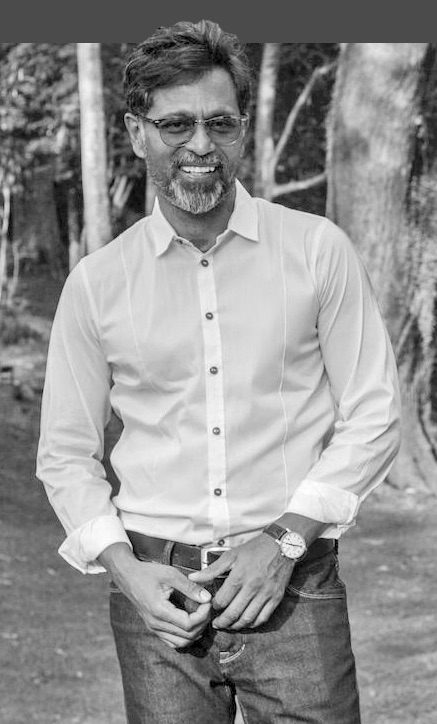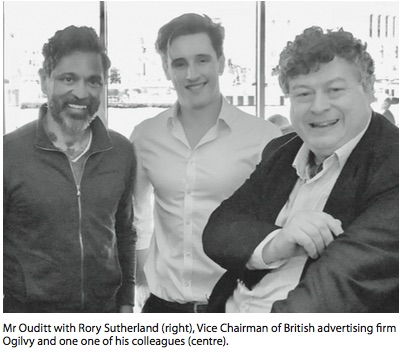Steve Ouditt shares his vision for social change through creativity and critical thought

Steve Anthony Ouditt finds himself at the intersection of pragmatism and imagination. He is not unlike many of his colleagues at the Department of Creative and Festival Arts (DCFA) at UWI St Augustine, but what makes him unique is his drive to use art and design for social change.
It was this drive, he believes, that led him to become the first-ever Senior Lecturer in Art and Design at the St Augustine Campus. And, after doing some sleuthing on his own, he is convinced that he may very well be the first senior lecturer in this field throughout all of the UWI campuses.
But deeper than that, his character and experiences tell the story of a man with strong convictions and a knack for tinkering away at problems that need solving.
“If you practise art and design for social change, it is not just going to make placards,” he says, explaining that these fields provide a wider scope for problem-solving. He bemoans society’s rigid adherence to algorithms and statistics, and advocates for the inclusion of human expression and the critical use of the intellect.
To understand his convictions, it is necessary to understand his history. Ouditt grew up in the 1960s, the period when Caribbean revolutionaries and thinkers proliferated. He was immersed in the wonderland of books, soaking up their adventures and teachings just as a paintbrush would when dabbed on a palette. He also frequented his neighbourhood Hosay yard, which moulded his inclinations towards design.
Ouditt reminisces fondly on his formative years, acknowledging that he made the important decision to discontinue his studies in Zoology, Botany and Chemistry, and eventually travel to New York to study Fine Arts at the School of Visual Arts. It was at this school that he discovered a particular course, Constructive Design, which helped to concretise his conviction that design could be used for social change. Electives in politics also helped to shape his worldview.
“I don’t think we in the Caribbean could out- manufacture the more industrialised countries, but I absolutely know we can compete with our knowledge capital,” he posits.
He emphasises that creatives don’t just use one medium, they use almost any platform they can to convey the deeply political questions they have, whether it is about the environment, their bodies or human rights.
Designing is not merely about making a handbag, or a pot. Ouditt explains that designers understand human factors, such as how people live and work and what they value. Such conscientious designing could help to design equality in societies.
Now, fast-forward from the decade he spent in New York. He then made his way to London, where he curated work representing minority ethnic communities. By this time, he was wholly immersed in working for social change. He knew that every piece was a statement, as well as something that could stimulate the imagination towards new possibilities.
When he came to The UWI in 2003, as a lecturer in Fine Arts and later Design, it was an opportunity for him to cultivate these concepts in the minds of his students. He says that when he teaches, particularly his Fine Arts course, he emphasises that creatives don’t just use one medium, they use almost any platform they can to convey the deeply political questions they have, whether it is about the environment, their bodies or human rights.
“When they start to see that, then they start to think that they can make work about the things that they believe in. They get a chance to see that their work is beyond the precious object,” he explains. “Art is really not a material practice. Art is informed by the intellect of the artist that decides to practise it.”

Outside of the UWI, Ouditt exemplifies what it means to live and breathe your passion. Just recently, he led the formation of the Caribbean’s first Behaviour Change Network in collaboration with the Arthur Lok Jack Global School of Business and with the endorsement of Ogilvy, a leading marketing and public relations agency in London.
Now, this probably begs the question, how do art and design interact with behaviour change? Behavioural change is a key component of social change, according to Ouditt, and understanding the interface between the two helps to clarify how the arts impact society.
Ponder upon the ways you can encourage an obese population to eat healthier. Would you emphasise a healthy, balanced diet and exercise? How do you reconcile that agenda with the easy accessibility of fast food (which is also quite inexpensive)? Designing for behavioural change would consider placing healthier food options in more accessible places and place fast food joints in less accessible areas. The option for fast food still exists, but getting it requires more effort. It is this type of critical thinking that can be applied to solving problems with a consciousness of the social inequalities that exist.
“I am very clear that all disciplines can contribute to social development, but I think design, and designing has, for many years, shown that it is one of the leading disciplines in social development,” the Senior Lecturer affirms.
It is a conviction that he has made it his life’s work to help others understand.